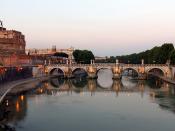The ancient Romans were similar to todays generations in their eating habits but never ate three hearty meals a day. Ientaculum and prandium were merely appetizers that filled their stomachs unitl the large cena, the event they look forward to since awakening. They had names for their meals similar to ours, breakfast (ientaculum), lunch (prandium), and dinner (cena).
Breakfast, ientaculum was usually taken about nine o'clock and consisted of merely a few pieces of bread sprinkled in salt or dipped in wine, and with a few raisins and olives, and a little cheese added. The poorest Romans ate little other than wheat either crushed to make a porridge or ground into flour for bread.
Lunch, or prandium was usually taken at noon. It was usually nothing more than a piece of bread accompanied by cold meat, vegetables, and fruit washed down with a glass of wine. Both ientaculum and prandium were so short there was no need to set the table or wash ones hands.
The only serious meal was the evening dinner or cena. Dinner time was practically the same for all Romans due to the lack of artificial light. Dinner was after the bath at the end of the eigth hour in winter and at the ninth in summer. The food is mostly cold,-breads, salads, olives, cheeses, and meats remaing from last nights dinner. Occasionally, hot dishes such as ham and pig's heads are feasted upon. Some wealthy Romans would have as many as seven courses to feed on.
Trimalchio, a wealthy Roman would have a bronzed donkey with appetizer dishes of olives, stuffed dormice rolled in honey and poppy seed, hot sausages were laid on a silver grill next to pomegranate and damson seeds. The guests were still busy with the hors d'oeuvres when a tray would...
![[Forum Boario, Rome, Italy] (LOC)](https://s.writework.com/uploads/17/171586/forum-boario-rome-italy-loc-thumb.jpg)
![[Piazza Navona, Rome, Italy] (LOC)](https://s.writework.com/uploads/5/50515/piazza-navona-rome-italy-loc-thumb.jpg)
